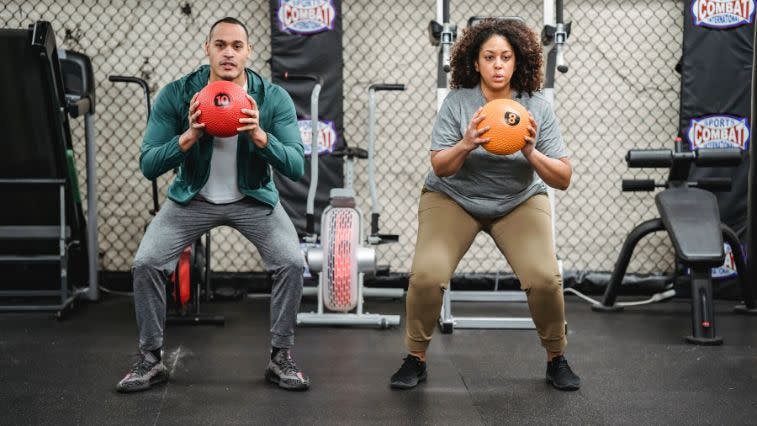Your One-Week Plan of Best Exercises for Weight Loss, Straight From Fitness Pros
Our content strives to support, inform, and motivate you to meet your health goals. We want to be your trusted source of expert- and science-backed info dispensed in simple, actionable ways. Read our Editorial Guidelines.
Searching for the best exercises for weight loss is certainly much easier than doing the actual workout! While the most effective weight loss strategy requires a comprehensive approach — including proper nutrition, good sleep, health-supporting habits — the best exercises for weight loss are actually a combination of exercises, specifically, cardiovascular and strength training moves.
We conducted lots of research and consulted three fitness experts to provide you with a detailed overview of these exercises and why they’re such effective tools for those who want to shed a few pounds (and keep them off).
How Do Our Bodies Burn Fat?
Even if you’re a fitness “newbie,” you probably already know that exercise can help you lose weight. What you may not know, however, is why.
The science behind weight loss is quite complex, but a basic knowledge of how your body burns fat can help you understand why both cardio exercises and strength training are especially ideal for those who want to lose weight.
Just like gas powers your car, your body is powered by its own type of “fuel.” This fuel (from food, water, etc.) not only helps you move but also equips you for a variety of functions necessary for survival. Also like a gas tank, your body doesn’t typically need a lot of fuel at once unless you’re eating while hiking long distance or running an ultra-marathon. It stores any fuel you don’t use immediately as glycogen in the liver and muscles. When your liver and muscle cells are full (there’s a finite amount of room for glycogen there), any extra fuel gets stored in fat cells. And, contrary to what you want to read, there’s tons of room for fat storage.
If you’re consistently taking in more fuel than your body uses, those reserves build up and create excess body fat.
Exercise gives your body a reason to tap into those reserves, because your muscles need energy to operate. When you exercise, fat cells release that energy into the bloodstream, so it can travel to whatever muscles need it. Your fat cells shrink and expand to accommodate their contents, which is why we “lose” or “burn” fat when we exercise.
Now that you have a basic idea of what happens in the body when you burn fat, let’s discover how cardio exercises and strength training aid this process.
Cardio

Cardiovascular exercise (cardio), also called aerobic exercise, involves multiple muscle groups working together at a rapid pace, which results in an increased heart rate. Some examples include:
Walking/jogging/running
Rowing
Cycling
Dancing
Swimming
Jumping rope
We talked about how burning fat involves fuel stored in our fat cells, but oxygen is one of the many necessary elements our bodies need to break down those cells. This is why your heart rate rises and your breathing grows faster and deeper during cardio exercise: your heart is trying to beat faster to pump more blood, oxygen, and energy throughout the body. Once our bodies use that oxygen, it’s converted to carbon dioxide, which leaves the body when we exhale.
“Cardiovascular exercise… uses up a lot of oxygen and glucose within the muscle tissue,” says Bill Daniels, a personal trainer and certified life coach. “In order to supply the muscles with more nutrients to keep them going, we need to increase blood flow. This results in the heart beating faster to keep up with the demand of the muscles. The end result is burning a lot of calories to keep your body going.”
Jogging, for example, is a form of cardio exercise. When you jog, you’ll breathe faster and deeper to get more oxygen to your bloodstream, and then your heart will pump harder and faster to get that oxygen to your muscles. In fact, “cardiovascular” means “relating to the heart and the blood vessels,” while the word “aerobic” actually means “with oxygen.”
Types of Cardio Exercises
Cardio aims to increase your heart rate, but these exercises can vary significantly in intensity, impact, and more.
Intensity
The intensity of an aerobic exercise correlates to how much that exercise increases your heart rate. For instance, walking, jogging, and running are all forms of cardio, but they vary in intensity, from low to moderate to high.
According to the American Heart Association, a moderate-intensity aerobic workout requires roughly 50–70% of your maximum heart rate, while high-intensity exercise demands 70–85%.
Impact
While intensity refers to a workout’s degree of difficulty (and its demand on your heart rate), impact refers to how a workout affects your joints.
A high-impact aerobic exercise might be jumping rope, which is harder on the joints in your feet, knees, and hips. A low-impact workout, on the other hand, would be swimming.
Interval vs. Steady State
HIIT (high-intensity interval training) is likely the most well-known form of interval training today. We’ve already discussed the meaning of intensity in a workout setting, but interval indicates an alternating exercise pattern. In a HIIT workout, for example, you alternate between 20–60 seconds of high-intensity intervals and 10–30 seconds of rest.
Steady-state cardio implies the opposite: a steady workout pattern that keeps your heart rate consistent. Jogging at a steady pace for 20 minutes is an example of a steady-state workout.
Best Cardio Exercises for Weight Loss
It’s true that a harder workout, or a high-intensity workout, results in more calories burned than a low- or moderate-intensity workout. In fact, one study found that participants who engaged in HIIT exercises burned 25–30% more calories than those performing lower-intensity exercise routines over the same amount of time. In our fast-paced world, it’s no wonder HIIT workouts have become so popular!
But, burning more calories in a shorter period of time has its drawbacks. In one study, the recovery time for those who pursued high-intensity training was greater than those who engaged in a steady-state cardio regimen. The HIIT subjects experienced a much lower level of enjoyment. These side effects can seriously impact an individual’s ability to maintain their exercise routine long term, which is why certified personal trainer and nutrition coach Ben Reale suggests low-intensity, steady-state cardio for his clients.
“Too many people believe that it has to be high intensity or it is a waste of time,” says Reale. “I disagree. Packing a training program full of moderate- or high-intensity exercise simply because it burns more calories is unsustainable and will lead to burnout from even the most experienced fitness enthusiast.”
The American Heart Association recommends a minimum of 150 minutes of moderate-intensity aerobic activity per week, which can include jogging, riding your bike, or even dancing! Experts also advise you to aim to lose just 1–2 pounds (or 1% of your overall body weight) per week.
Strength Training

The primary function of cardio exercises is to boost your heart rate and get your blood flowing, so your muscles can get the energy they need to move. In strength training — also called resistance training or weight training — the primary goal is to build muscle. Some examples of strength training include:
Squats
Push-ups
Pull-ups
Lunges
Deadlifts
Chest presses
Back rows
Strength training increases the size of your muscles, but the reason it’s so effective for weight loss is because it also increases your basal metabolic rate (BMR). Your BMR is the amount of calories you burn doing everyday, life-sustaining activities — and it accounts for a whopping 60%–70% of the energy your body needs. That’s a big chunk of calories all on its own, and strength training ups the ante.
“Strength training is an important part of losing weight, because the more muscle tissue that we have in our bodies, the more calories we burn on a day-to-day basis just to maintain that muscle,” says Daniels. “Resistance exercise is great for long-term calorie burning.”
Aerobic exercises help you burn calories as you work out, but strength training can further assist your weight loss journey by burning calories as you exercise and when you’re not working out at all!
Types of Strength Training
As with cardio exercises, there are a variety of different types of resistance training, many of which can benefit your weight loss journey.
Hypertrophy
Strength, as a general term, refers to your body’s ability to recruit your muscle fibers to act. It’s about the relationship between your nervous system and your muscles.
Hypertrophy refers to the size of those muscular fibers. For this reason, hypertrophy training is often utilized by bodybuilders.
Repetitions and Intensity
Repetitions (reps) are the number of times you perform a specific exercise (such as bicep curls). Intensity means how hard you work. In the context of reps during strength training, intensity refers to how much weight you lift during the exercise (such as 5-pound or 25-pound weights) and the effort you exert to move those weights (lifting with a burst of power or slowly lowering for a count of three, for example).
Reps and intensity are closely connected. In general, higher reps and lower weight increases muscular endurance. Heavier weight and lower reps buildsmuscle size (hypertrophy).
Isometric
With repetitions, you perform a single movement, such as a squat or push-up, multiple times. During an isometric exercise, you build muscle by holding a specific position for a set period of time. Examples of isometric exercises include planks or wall squats.
Circuit Training
Circuit training combines a variety of exercises, generally organized into “stations,” to target all major muscle groups. At each station, the specific exercise — such as a plank at one station and chest press at another — lasts for a certain duration (typically between 30 seconds and three minutes) or a number of reps (such as 10–25).
Circuit training has the added benefit of increasing your heart rate as you move from station to station, so it’s a great way to incorporate both cardio and resistance training.
Best Strength Training Exercises for Weight Loss
When it comes to strength training for weight loss, Daniels recommends exercises that use bigger muscle groups, such as the legs, glutes, back, and chest. Since our bodies burn calories by simply maintaining muscle mass, focus on these larger muscle groups to increase long-term calorie burning. Some of Daniels’ suggestions include push-ups and pull-ups.
“I usually will put this into a circuit format, [which] keeps the heart rate up and adds a little cardiovascular exercise to the workout. Alternating between upper body and lower body also makes the entire system work a little bit harder to keep blood flowing to the muscles that need it,” says Daniels.
Reale follows guidelines set by the Centers for Disease Control and Prevention (CDC) and encourages his clients to engage in two to four days of strength training per week. He too prefers exercises that offer more “bang for your buck,” which is why Reale recommends full-body exercises for his clients.
“I would recommend two to four days per week of full-body resistance training, meaning the person will prioritize the six movement patterns [push, pull, squat, lunge, hinge, and rotation] for each resistance training session or some variation of the movement patterns throughout the week,” says Reale. Some of these exercises include bench presses and squats.
What About Yoga and Pilates?

In a nutshell, Pilates focuses on functional strength, mobility, as well as core strength and stability. Yoga focuses on mindfulness, mobility, and flexibility. These specific exercise methods offer a wide variety of benefits, but by themselves, are not the most ideal tools if weight loss is your primary goal.
Certified personal trainer and nationally certified Pilates instructor Chandel Stallworth says so herself: “[Pilates] was never designed to be, and should not be considered a ‘go-to’ exercise method to achieve weight loss.”
As we’ve already established, weight loss is complex. Burning fat involves a wide range of processes happening simultaneously or in quick succession. This is why both aerobic activities and resistance training can help you lose weight because they accomplish different functions in the fat-burning process.
While yoga and Pilates are not the “best” forms of exercise for weight loss, evidence shows that both yoga and Pilates can assist in your weight loss journey. Some benefits of practicing yoga and Pilates include improved eating habits, decreased stress and anxiety, and enhanced muscle strength, all of which can improve your journey to better health.
“Pilates will help you become more in tune with your body,” says Stallworth. “It will increase your flexibility, strengthen your entire core including the muscles that support your spine, and allow you to have greater control over your mind-body connection.”
Sample Weekly Plan for Weight Loss Exercises
The best plan for weight loss utilizes a combination of cardio exercises and strength training. Our sample workout plan was provided by a certified fitness professional. This particular plan alternates between cardio days and full-body resistance training days, and it concludes with a final recovery day (during which you could incorporate some yoga).
Monday: Strength Training (full-body resistance workout)
Superset 1:
Kneeling Dumbbell Row x 10–12 reps (3 sets)
Dumbbell Bench Press: 10–12 reps (3 sets)
Superset 2:
Split Squat x 6–8 reps per side (3 sets)
Air Squat x 8–10 reps (3 sets)
Superset 3:
Dumbbell Skullcrusher x 10–12 reps (2 sets)
Dumbbell Bicep Curl x 10–12 reps (2 sets)
Side Plank x 20–30 seconds per side (progress up to 60 sec. per side)
Tuesday: Cardio
Walk for 45–60 minutes at a low-intensity pace
Wednesday: Strength Training (full-body resistance workout)
Superset 1:
Kettlebell Romanian Deadlift x 8–10 reps (3 sets)
Seated Dumbbell Neutral Grip Overhead Press x 8–10 reps (3 sets)
Superset 2:
Goblet Squat x 8–10 reps (3 sets)
Cable Lat Pulldown x 10–12 reps (3 sets)
Superset 3:
Incline Dumbbell Bench Press x 10–12 reps (2 sets)
Front Plank x 20–30 seconds (progress up to 60 sec.)
Thursday: Cardio
Row or bike for 20–30 minutes at a low-intensity pace
Friday: Strength Training (full-body resistance workout)
Superset 1:
Neutral Grip Dumbbell Bench Press x 8–10 reps (3 sets)
Seated Cable Row x 8–10 reps (3 sets)
Superset 2:
Kettlebell Goblet Squat Good Morning x 8–10 reps (3 sets)
Box Step-Ups x 12–16 reps (3 sets)
Superset 3:
Air Squat x 12–15 (2 sets)
Bent Hollow Hold or Hollow Rocks x 20–30 seconds
Saturday: Cardio
Walk or hike for 30–45 minutes at a low-intensity pace
Sunday: Recovery Day
Work on flexibility and mobility (as needed) with yoga exercises
Walk for a minimum of 15–20 minutes
As you perform the exercises listed, try to increase your difficulty level over time. “The most effective types of exercises that help you lose weight will challenge and push you a little bit outside of your comfort zone,” says Daniels.
As you modify your workouts, make sure you’re aware of your limitations and avoid any exercises that could injure you. “Ultimately, I want it to feel like a 7 out of 10 in terms of perceived intensity,” suggests Daniels.
With all this said, even simple activities like walking or riding your bike can help you lose weight. The real key is consistency. “In order for the ‘novice’ client to lose weight and sustain their new body composition, it will require them to be consistent for the long term,” says Reale.
How to Maintain an Effective Weight Loss Journey
Weight loss is more complex than adjusting the calories coming in and out of your body. In fact, studies show that a wide range of factors can impact weight gain, including social, psychological, and environmental contributors. An effective weight loss program should involve more than just exercises.
“I always tell my clients that weight loss begins in the kitchen and ends in their bed,” says Stallworth. “Being in a slight caloric deficit and ensuring that they get enough rest on a daily basis are crucial.”
This is why, when you’re trying to lose weight, it’s important to lean on qualified health and fitness professionals for advice along the way. Get a free consultation with a personal trainer who can guide you on your weight loss journey and design a balanced, customized exercise plan to help you lose weight.